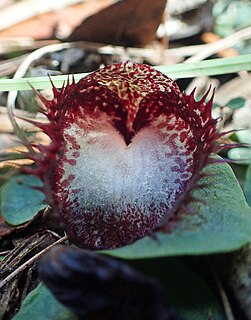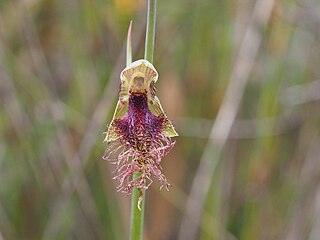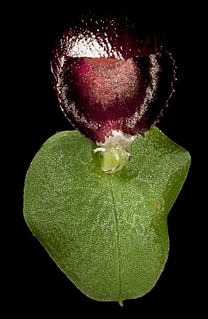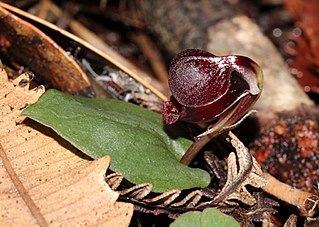Acianthus collinus, commonly known as hooded mosquito orchid or inland mosquito orchid, is a flowering plant in the orchid family Orchidaceae and is endemic to New South Wales and Victoria in Australia. It is a terrestrial herb with a single, heart-shaped leaf and between two and nine translucent pinkish flowers with reddish markings and is found growing in colonies on sheltered slopes in open forest in on the western slopes of the Great Dividing Range.
Caladenia dorrigoensis is a plant in the orchid family Orchidaceae and is endemic to New South Wales. It has a single leaf and a single white flower with purple marks on its labellum.

Corybas hispidus, commonly known as the bristly helmet orchid, is a species of orchid endemic to eastern Australia. It is distinguished from other helmet orchids by its autumn to winter flowering period, and by its labellum, which has a bristly-hairy, creamy-white centre and is deeply notched along its top edge.

Pterostylis amabilis is a species of orchid endemic to eastern Australia. As with similar orchids, the flowering plants differ from those which are not flowering. The non-flowering plants have a rosette of leaves but the flowering plants lack a rosette at the base but have up to ten tiny white and red to reddish-brown flowers. It is similar to P. parviflora but has larger rosette leaves and larger, more brightly coloured flowers.

Prasophyllum caudiculum, commonly known as the Guyra leek orchid, is a species of orchid endemic to a small area of northern New South Wales. It has a single tubular, bright green leaf and up to thirty five greenish to reddish-brown flowers crowded along an erect flowering stem. It grows in grassy places near Guyra.

Calochilus russeus, commonly known as the reddish beard orchid, is a species of orchid endemic to the Northern Tablelands of New South Wales. It has a single thick, dark green leaf and up to twelve greenish flowers with red stripes and a hairy labellum which is the largest part of the flower. It is a rare orchid, growing as isolated individuals near Ebor.
Corybas abditus, commonly known as the swamp helmet orchid or small helmet orchid , is a species of terrestrial orchid endemic to Western Australia. It is a rare orchid with a single bluish green, heart-shaped leaf and a small flower with an enlarged dorsal sepal and tube-shaped labellum.
Corybas abellianus, commonly known as the nodding helmet orchid, is a species of terrestrial orchid endemic to tropical north Queensland. It forms small colonies and has single heart-shaped, dark green leaf with a silvery white lower side and a reddish purple flower with a curved dorsal sepal.

Corybas barbarae, commonly known as fairy lanterns, is a species of terrestrial orchid endemic to eastern Australia including Lord Howe Island. It has a single dark green or reddish green, heart-shaped leaf and a small sparkling white or pinkish flower with an inflated dorsal sepal obscuring its hairy labellum.

Corybas diemenicus, commonly known as the stately helmet orchid or veined helmet orchid, is a species of terrestrial orchid endemic to south-eastern Australia. It has round or heart-shaped leaf and a reddish purple flower with a central white patch.
Corybas expansus, commonly known as the flared helmet orchid, is a species of terrestrial orchid endemic to South Australia. It has a heart-shaped to more or less round leaf and a single purplish flower with greenish or transparent areas. It is a vulnerable species, found in near-coastal sand and leaf litter.
Corybas fordhamii, commonly known as the banded helmet orchid or swamp helmet orchid, is a species of terrestrial orchid endemic to south-eastern Australia. It has an egg-shaped to heart-shaped leaf and a reddish to reddish purple flower which leans forward. It is similar to C. unguiculatis which does not grow in swamps and has a different labellum.

Corybas incurvus, commonly known as the slaty helmet orchid, is a species of terrestrial orchid endemic to south-eastern Australia. It has a broad egg-shaped to heart-shaped leaf and a dark purple flower with a white patch in the middle.
Corybas × miscellus, commonly known as the hybrid helmet orchid, is a hybrid species of terrestrial orchid endemic to South Australia and a very small area in far western Victoria. It has a heart-shaped to more or less round leaf and a single reddish purple flower with greyish translucent areas. It is a natural hybrid between C. diemenicus and C. incurvus and shares the characteristics of the parent species.

Corybas recurvus, commonly known as the western helmet orchid or common helmet is a species of terrestrial orchid endemic to Western Australia. It has round or heart-shaped leaf and a dark reddish purple or purplish black flower. It is widespread and common between Bunbury and Albany.

Corybas undulatus, commonly known as tailed helmet orchid, is a species of terrestrial orchid endemic to eastern Australia. It has a single leaf and a single translucent grey flower with reddish markings, and a labellum with a bristly surface, fine teeth on the edge and a small tail on the tip.

Corybas unguiculatus, commonly known as the small helmet orchid or pelicans, is a species of terrestrial orchid endemic to south-eastern Australia. It is a widespread, sometimes common but small orchid with a single leaf and a single reddish purple to reddish black flower.

Prasophyllum basalticum is a species of orchid endemic to New South Wales. It has a single tubular, dark green leaf and up to fifteen scented, greenish-brown to brownish-red flowers with a white and green labellum. It grows in grassy woodland on the Northern Tablelands.
Prasophyllum brevisepalum is a species of orchid endemic to New South Wales. It has a single tubular, shiny dark green leaf and up to thirty five scented, yellowish to brownish green and white flowers. It is only known from a single population growing in woodland near Inverell.
Prasophyllum pictum is a species of orchid endemic to New South Wales. It has a single tubular, shiny dark green leaf and up to twenty two scented brown, pink, purple and white flowers. It is only known from three subpopulations on the Northern Tablelands.










